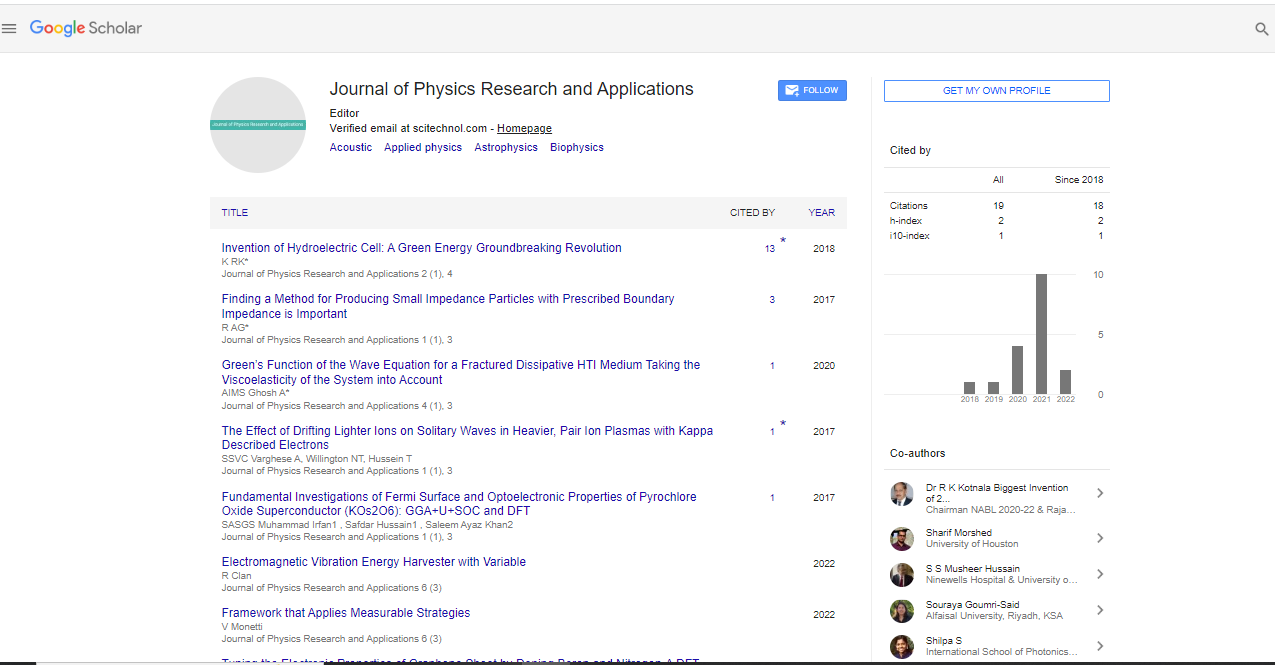Perspective, J Phys Res Appl Vol: 8 Issue: 4
Advancements in Nanotechnology for Drug Delivery and Medical Treatments
Mustafa Aziz*
1Department of Physics, University of Arkansas, Arkansas, USA
*Corresponding Author: Mustafa Aziz,
Department of Physics, University of
Arkansas, Arkansas, USA
E-mail: aziz@mst.edu
Received: 19 November, 2024, Manuscript No. JPRA-24-156510;
Editor assigned: 21 November, 2024, PreQC No. JPRA-24-156510 (PQ);
Reviewed: 06 December, 2024, QC No. JPRA-24-156510;
Revised: 13 December, 2024, Manuscript No. JPRA-24-156510 (R);
Published: 20 December, 2024, DOI: 10.4172/JPRA.1000130.
Citation: Aziz M (2024) Advancements in Nanotechnology for Drug Delivery and Medical Treatments. J Phys Res Appl 8:4.
Description
Nanotechnology is the science of changing matter at the atomic and molecular scale has emerged as a transformative tool in the field of medicine. One of its applications is in drug delivery, where nanoscale materials are used to improve the targeting, efficacy and controlled release of therapeutic agents. Nanotechnology used to enhance medical treatments by enabling the development of more effective drugs with fewer side effects, as well as advancing diagnostic techniques and improving overall patient outcomes. The traditional methods of drug delivery often face significant challenges, including poor solubility, limited bioavailability and difficulty in targeting specific cells or tissues. These limitations can result in drugs being ineffective or causing unwanted side effects. Nanotechnology addresses many of these issues by enabling drugs to be delivered more efficiently and precisely. Nanoparticles, which are typically between 1 and 100 nanometers in size, can be engineered to encapsulate drugs, allowing them to be transported through the body more effectively. These particles can be designed to release their payloads in a controlled manner, having several key advantages over conventional drug delivery methods.
One of the most significant benefits of nanotechnology is its ability to target specific cells or tissues. Nanoparticles can be engineered to recognize and bind to particular receptors on the surface of diseased cells, such as cancer cells. This targeted approach minimizes the effect of the drug on healthy cells, reducing the risk of side effects. For example, liposomes and polymeric nanoparticles can be designed to target cancer cells, delivering chemotherapy drugs directly to the tumor site, which not only enhances the drug's efficacy but also reduces damage to healthy tissues.
Nanotechnology allows for the development of drug delivery systems that can release their contents slowly over time. This controlled release mechanism ensures that a constant concentration of the drug is maintained in the body, improving the therapeutic effect and reducing the frequency of administration. Nanoparticles can be designed to release drugs in response to changes in the environment, such as pH, temperature or specific enzymes. This makes it possible to create long-acting formulations for chronic diseases like diabetes, where insulin can be released gradually to maintain stable blood sugar levels.
Many drugs have poor water solubility, which limits their absorption in the body and reduces their effectiveness. Nanoparticles can enhance the solubility of these drugs by encapsulating them in carriers that improve their absorption. For example, nanoparticles made from lipids or polymers can be used to encapsulate hydrophobic drugs, allowing them to dissolve in aqueous environments and be more easily absorbed by cells. This improves the bioavailability of the drug, ensuring that more of it reaches its target site.
Nanotechnology can reduce the toxicity of drugs by ensuring that they are released only at the desired site of action. By avoiding systemic circulation, the drug can be delivered directly to the diseased area, minimizing side effects that are typically caused by drugs interacting with healthy tissues. This targeted approach is particularly important in chemotherapy, where conventional treatments often result in severe side effects due to the indiscriminate distribution of the drug throughout the body. Nanotechnology has the potential to revolutionize diagnostic techniques by enabling more sensitive and specific detection of diseases at earlier stages. Nanoscale materials, such as gold nanoparticles and quantum dots, can be used in diagnostic assays to detect biomarkers associated with diseases like cancer, infections and cardiovascular conditions. These nanoparticles can be engineered to bind to specific biomolecules, allowing for the detection of diseases even at very low concentrations. This sensitivity can lead to earlier diagnoses, improving the chances of successful treatment.
 Spanish
Spanish  Chinese
Chinese  Russian
Russian  German
German  French
French  Japanese
Japanese  Portuguese
Portuguese  Hindi
Hindi 
